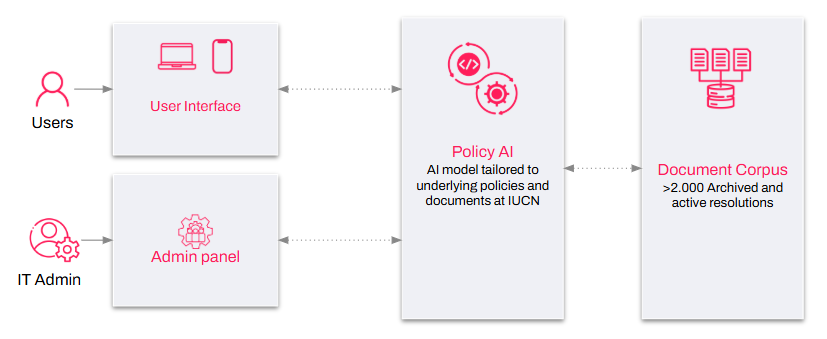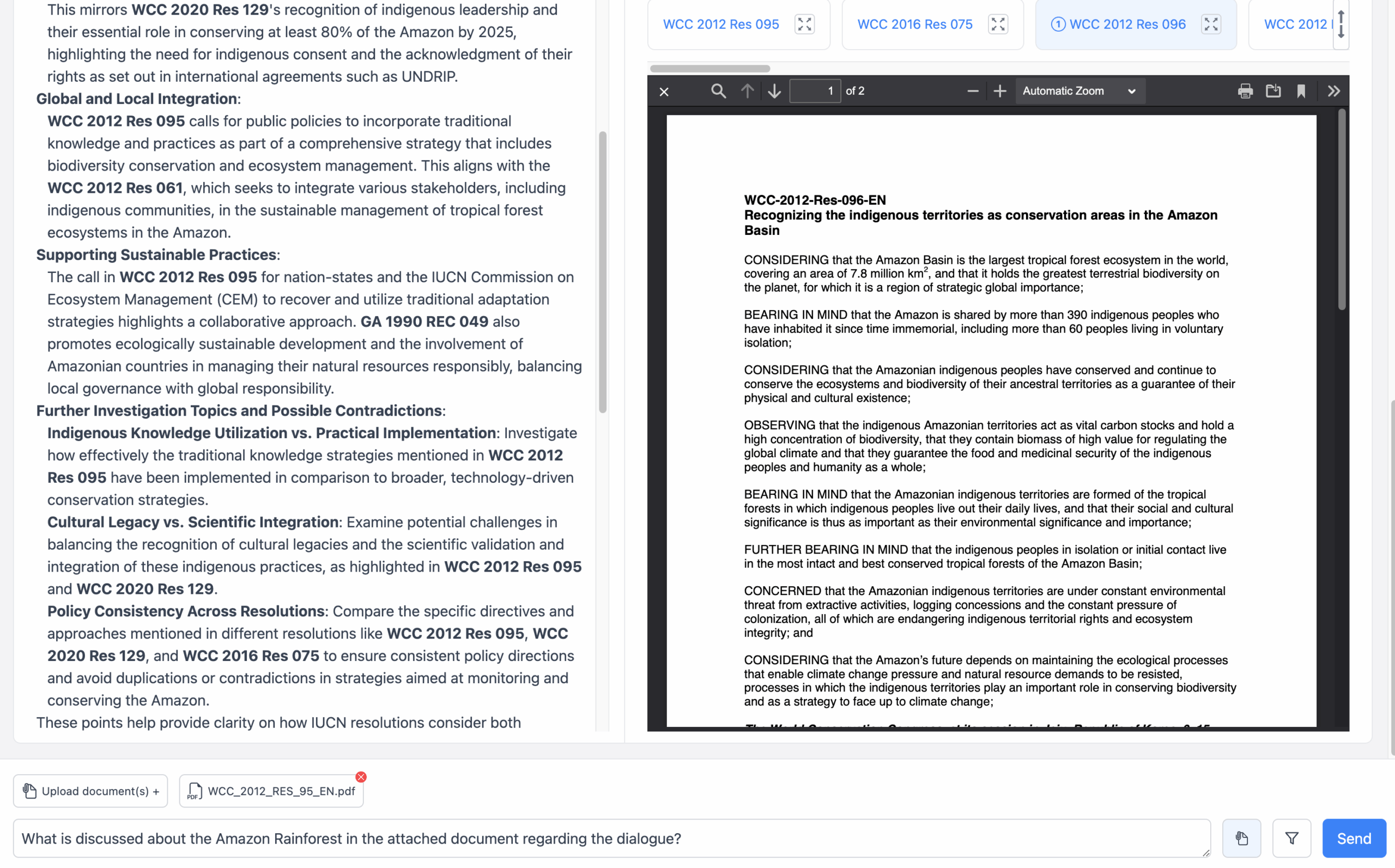Manual policy management in 2025? That often means sifting through outdated files, checking what’s still active, and spending hours trying to piece everything together.
If that sounds all too familiar – and exhausting – you’re in the right place.
On May 7, 2025, S-PRO hosted a webinar on how intelligent automation is redefining compliance. Drawing on experience from over 50 machine learning and data projects – well before Gen AI hype took off – our Digital Strategy & Solutions Lead, Dustin Schulze, shared how we tackled a challenge for the International Union for Conservation of Nature (IUCN).
They were managing 1,466 archived and 695 active resolutions manually. We helped relieve that burden with a smart, automated solution, ChatR&R.
In this post, we’ll discuss how policy automation software works and how ChatR&R brought clarity and control to a complex global organization.
What Are the Core Components of Effective Policy Management?
The policy and procedure management lifecycle is a complex process that requires structure, clarity, and regular upkeep. The key stages – i.e., components – every policy should go through include:
Creation: Where It All Begins
Every policy starts with a need. It can be anything, for example, meeting a regulatory requirement, managing areas of risk, or setting certain expectations.
Once it’s known that a policy is needed, the next step is to decide who is in charge. It means assigning an “owner” – a person, a specific team, or an organization responsible for that policy.
Then comes the drafting, where the policy actually gets written, followed by reviews and approvals.
Communication: Making Sure It Reaches the Right People
Creating a policy is part of the job. The next step is to ensure that everyone is on the same page. How exactly?
First of all, the policy gets published. And since the people need to understand what this policy means for them, some sort of training – such as explanatory videos or real-life examples – can be used.
Management: Enforcement and Exceptions Handling
Having a policy on paper is great. However, it has to be enforced to have any meaningful impact. If people think it’s optional, they’re less likely to stick to it. That’s why policyholders should monitor how the workforce follows their policies.
That said, not every rule fits every situation. Sometimes, bending the policy makes sense. Thus, having an exception management strategy is also necessary.
Maintenance: Keeping Everything Up to Date
Policies shouldn’t be static. Review them regularly so they would stay effective. This often happens annually or even more frequently. If the policy is outdated, it gets reworked. If it’s still solid, the review date is added.
And finally, archiving. This involves keeping a record of every policy and every version of it for future reference, audits, or investigations.
What Major Policy Management Challenges Can You Automate?
The policy management process sounds straightforward – an easy-to-follow four-step cycle. And if you’re only dealing with several policies, that might be the case. But what if you have hundreds of them?
You’ll likely face bottlenecks. The good news? These very challenges are perfect candidates for intelligent automation. Let’s go through each.
Complexity and Sheer Volume
Remember our client, IUCN? They had to juggle 2,161 different policies – both archived and active. Many other organizations face the same. They have policies for everything from HR and IT to compliance and ethics. And as the companies grow, so does the list.
It’s not just the volume that’s a challenge. It’s also the complexity. Policies can be intricate and include legal, technical, and procedural language, which makes them difficult to keep track of and review.
Manual Creation and Updates
Drafting policies in Word or handing out paperwork across departments? This isn’t necessarily wrong. Yet, the lack of centralization can lead to version mix-ups, outdated documents, and a significant risk of inconsistencies or policy violations.
Sluggish Search and Access
Most people won’t read a policy that’s buried in an email chain or handed to them in a binder. And if policy enforcers can’t even find the rules, how can they explain or uphold them? For policies to be effective, organizations need a simple, fast way to access them, which is exactly the kind of solution policy management software provides.
How Does Policy Automation Software Revolutionize Your Workflow?
Now that we’ve explored the common challenges of policy management, let’s see how intelligent policy automation software can tackle them, using our solution for the IUCN as an example.
Start Small, Get Results Fast
Instead of jumping into full-scale development, we did what we always do: started with an MVP – a minimum viable product. The goal? Launch the first version with just enough features to deliver real value quickly, leaving room for feedback, improvement, and scale. As Dustin Schulze put it during the webinar:
That way, you make sure that you have tangible results very fast. Then you adapt based on what users actually need.
Design a UI That Doesn’t Need a Manual
After a simple login, users land on a clean, intuitive dashboard. No training videos. No onboarding friction. Just an elegant interface where they can immediately ask questions or explore documents.
You don’t need any crazy training on that. You just give it to people and they’ll understand how to navigate around that.
Use the Right Foundation
At our solution’s core is a pre-built Policy AI model. We structured it around two key data sources:
- Internal data – active and archived policies, user requests and feedback
- External data – industry standards and guidelines, including ISO, DSGVO, etc
Feeding both sets of information into the model lets the system provide nuanced, context-aware responses.
Adapt to Client Workflows
Our ready-made model is a decent foundation.
What is great about developing such a tool once is that the core is kind of there,
Dustin Schulze explained. You can easily feed it with new documents. That’s precisely what we did for the IUCN.
Here’s how the solution tailored to our client’s workflows works:
- Users interact with the system through an easy-to-understand interface
- IT admins manage the system via an admin panel
- Both the user interface and admin panel connect to our Policy AI model, adapted to the IUCN’s policies and documents
- Our Policy AI model draws its knowledge from the Document Corpus – the massive collection of active and archived IUCN resolutions

Ready to See It in Action? Check Out the Live Demo!
Let’s now talk about functionality. Here’s what our policy automation software can do:
Natural Language Search

Instead of digging through endless folders on SharePoint or running lengthy keyword searches, users can simply ask questions in plain English.
Let’s say a policy writer is preparing a new resolution on Arctic preservation. Rather than sifting through past documents manually, they can just type the topic into the system. The assistant provides a structured response with a timeline, a summary of past actions, and links to relevant documents, as Dustin Schulze shows.
The search understands context, too. Ask about “ice bears” (a direct German-English translation) and it knows you actually mean “polar bears” – no keyword match required.
Traceability, Precision, and Interactivity

One of the biggest risks in using machine intelligence for compliance is the “black box” problem: you get an answer, but you have no idea where it came from.
Our solution fixes that by giving the users:
- Clickable references to the exact documents and paragraphs used to generate the response
- An interface that allows users to interact with the information – open any cited policy, view the full text, and see the relevant section highlighted
Why does that matter? Generic tools like ChatGPT or Gemini often hallucinate and provide made-up references – something you cannot afford in legal or regulatory work.
This whole topic of AI hallucination, while it’s always important, is especially important if we talk about policies,
Dustin Schulze notes.
Filters

Our client is dealing with over 2,000 documents, so, naturally, not every result is going to be useful. That’s why our policy management software lets users narrow search results down by applying filters.
In particular, you can filter by:
- Document type (for example, only decisions but not resolutions)
- Publication year
- Geographic region
- Policy status (active or archived)
You can also add filters directly into your question, like:
Show me Arctic-related decisions from 2014 that are still active.
And just like that, the assistant tailors your response accordingly.
Upload and Update

In ChatR&R, users can upload new policies or drafts at any time. The system automatically integrates them into the knowledge base.
Users can also ask the assistant for suggestions, for example:
How does this align with existing policies?
Once they get feedback, they can update the policies accordingly.
Duplicate and Conflict Detection
Before creating new policies, users can ensure that they don’t conflict with existing ones. Our solution detects overlapping, outdated, or contradictory policies. If two resolutions are saying the same thing – or worse, contradicting each other – the system flags them for review.
During the webinar, Dustin Schulze remarks:
This is a very good example of how AI helps us as humans to do our work way better.
Security and Compliance
Finally, working with policy and procedure management means that trust and compliance aren’t optional. That’s why our platform is built on Microsoft-grade infrastructure and backed by ISO 27001 and 27701 certification.
All in all, we built a policy automation software solution that has clear advantages over out-of-the-box and generic tools. ChatR&R helped the IUCN manage thousands of resolutions without losing clarity, context, or time.



